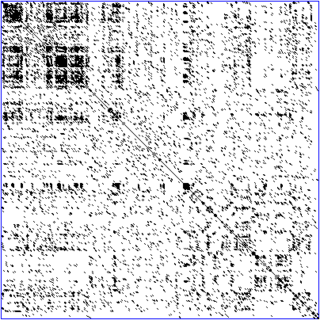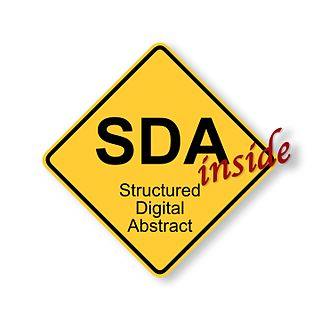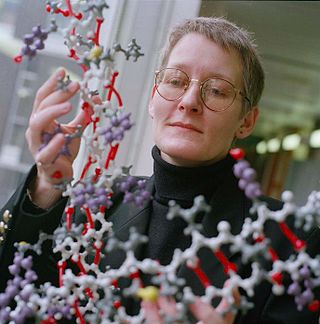
Bioinformatics is an interdisciplinary field of science that develops methods and software tools for understanding biological data, especially when the data sets are large and complex. Bioinformatics uses biology, chemistry, physics, computer science, computer programming, information engineering, mathematics and statistics to analyze and interpret biological data. The subsequent process of analyzing and interpreting data is referred to as computational biology.

In bioinformatics, a sequence alignment is a way of arranging the sequences of DNA, RNA, or protein to identify regions of similarity that may be a consequence of functional, structural, or evolutionary relationships between the sequences. Aligned sequences of nucleotide or amino acid residues are typically represented as rows within a matrix. Gaps are inserted between the residues so that identical or similar characters are aligned in successive columns. Sequence alignments are also used for non-biological sequences, such as calculating the distance cost between strings in a natural language or in financial data.
BioJava is an open-source software project dedicated to provide Java tools to process biological data. BioJava is a set of library functions written in the programming language Java for manipulating sequences, protein structures, file parsers, Common Object Request Broker Architecture (CORBA) interoperability, Distributed Annotation System (DAS), access to AceDB, dynamic programming, and simple statistical routines. BioJava supports a huge range of data, starting from DNA and protein sequences to the level of 3D protein structures. The BioJava libraries are useful for automating many daily and mundane bioinformatics tasks such as to parsing a Protein Data Bank (PDB) file, interacting with Jmol and many more. This application programming interface (API) provides various file parsers, data models and algorithms to facilitate working with the standard data formats and enables rapid application development and analysis.
The European Bioinformatics Institute (EMBL-EBI) is an intergovernmental organization (IGO) which, as part of the European Molecular Biology Laboratory (EMBL) family, focuses on research and services in bioinformatics. It is located on the Wellcome Genome Campus in Hinxton near Cambridge, and employs over 600 full-time equivalent (FTE) staff. Institute leaders such as Rolf Apweiler, Alex Bateman, Ewan Birney, and Guy Cochrane, an adviser on the National Genomics Data Center Scientific Advisory Board, serve as part of the international research network of the BIG Data Center at the Beijing Institute of Genomics.

The Biochemical Journal is a peer-reviewed scientific journal which covers all aspects of biochemistry, as well as cell and molecular biology. It is published by Portland Press and was established in 1906.
InterPro is a database of protein families, protein domains and functional sites in which identifiable features found in known proteins can be applied to new protein sequences in order to functionally characterise them.
This list of structural comparison and alignment software is a compilation of software tools and web portals used in pairwise or multiple structural comparison and structural alignment.
Semantic publishing on the Web, or semantic web publishing, refers to publishing information on the web as documents accompanied by semantic markup. Semantic publication provides a way for computers to understand the structure and even the meaning of the published information, making information search and data integration more efficient.

In bioinformatics a dot plot is a graphical method for comparing two biological sequences and identifying regions of close similarity after sequence alignment. It is a type of recurrence plot.
BLAT is a pairwise sequence alignment algorithm that was developed by Jim Kent at the University of California Santa Cruz (UCSC) in the early 2000s to assist in the assembly and annotation of the human genome. It was designed primarily to decrease the time needed to align millions of mouse genomic reads and expressed sequence tags against the human genome sequence. The alignment tools of the time were not capable of performing these operations in a manner that would allow a regular update of the human genome assembly. Compared to pre-existing tools, BLAT was ~500 times faster with performing mRNA/DNA alignments and ~50 times faster with protein/protein alignments.
In molecular biology, the PRINTS database is a collection of so-called "fingerprints": it provides both a detailed annotation resource for protein families, and a diagnostic tool for newly determined sequences. A fingerprint is a group of conserved motifs taken from a multiple sequence alignment - together, the motifs form a characteristic signature for the aligned protein family. The motifs themselves are not necessarily contiguous in sequence, but may come together in 3D space to define molecular binding sites or interaction surfaces. The particular diagnostic strength of fingerprints lies in their ability to distinguish sequence differences at the clan, superfamily, family and subfamily levels. This allows fine-grained functional diagnoses of uncharacterised sequences, allowing, for example, discrimination between family members on the basis of the ligands they bind or the proteins with which they interact, and highlighting potential oligomerisation or allosteric sites.

A Structured Digital Abstract (SDA) is a method of describing relationships between biological entities in a structured, but human-readable, format. It is added below the abstract of scientific articles published in FEBS Letters and FEBS Journal. Current SDAs describe protein-protein interactions.
Simple Modular Architecture Research Tool (SMART) is a biological database that is used in the identification and analysis of protein domains within protein sequences. SMART uses profile-hidden Markov models built from multiple sequence alignments to detect protein domains in protein sequences. The most recent release of SMART contains 1,204 domain models. Data from SMART was used in creating the Conserved Domain Database collection and is also distributed as part of the InterPro database. The database is hosted by the European Molecular Biology Laboratory in Heidelberg.
The NucleaRDB is a database of nuclear receptors. It contains data about the sequences, ligand binding constants and mutations of those proteins.
Utopia Documents is a semantic, scientific, web-enabled PDF reader that is part of the Utopia toolset. Utopia Documents can be downloaded for free.

Teresa K. Attwood is a professor of Bioinformatics in the Department of Computer Science and School of Biological Sciences at the University of Manchester and a visiting fellow at the European Bioinformatics Institute (EMBL-EBI). She held a Royal Society University Research Fellowship at University College London (UCL) from 1993 to 1999 and at the University of Manchester from 1999 to 2002.

Stephen Robert Pettifer is a Professor in the Department of Computer Science at the University of Manchester in England.
In bioinformatics, alignment-free sequence analysis approaches to molecular sequence and structure data provide alternatives over alignment-based approaches.







